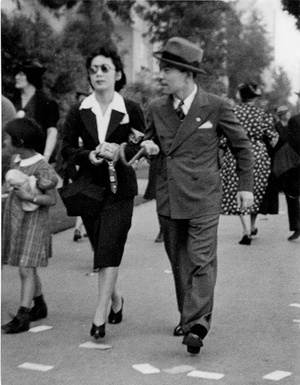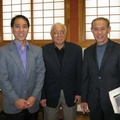7. Edna Ishikawa
Edna (née Sakoda) Ishikawa was born in Soledad, California, in 1920. She moved to “the city” in 1938 upon graduating from Gonzales High School in Gonzales, California, to follow her older sister, Fumiye. Actually auntie Fumiye lived in either Palo Alto or Los Gatos working for a white family. Edna worked as a secretary.
These types of jobs were “opportunities” for young women from the farms and rural communities to move to large urban cities and meet other like-minded people. The pay probably wasn’t great. However, the chance to experience life away from home was much more exciting than waiting for life to begin at home.
Recently, I found a photo of my mom online located at the University of California’s digital library website. No one in my family remembers seeing the photo. The photo displays my mom, “Mrs. Roy Ishikawa” on the right and two other young “Nisei” ladies posing for the American Red Cross in San Francisco.
Apparently, the photo was taken two-weeks after the bombing of Pearl Harbor and was labeled, “Loyal Americans All.” This photo looks like a "propaganda" photo to mitigate some of the fall out of negative stereotypes, prejudices, and hatred towards Japanese Americans popularly held by non-Japanese Americans against all Japanese Americans at the time. Though true to form my mom would volunteer to help others in need. She continued to volunteer at her church and in her community throughout her lifetime.

University of California Digital Library Archives Online, Dec. 21, 1941 – Mrs. Roy Ishikawa, right side of photo
8. Elopement
My parents originally wanted to marry in November of 1939. This date did not happen. I’m not quite for sure what put them off. Most likely it was because of my maternal grandma Sakoda, she may have been traditional and desired an older child to marry before her middle child. Moreover, dad’s family was no doubt even more traditional, especially his mother. His family was possibly surprised or even upset about my parents’ intention to marry. They did not know of my mom’s family.
Back in those days, marriages were arranged to known people of similar class backgrounds who usually lived nearby. My parents’ marriage was not arranged and the two families were not contextual to each other. (What kind of people were these two families?) In any event, I doubt my paternal grandparents gave their blessings to their only son. This would not be the first time that my maternal grandparents were “dissed” by future in-laws.
The stories about this postponed wedding were not iterated over and over again, and thus my conclusion that someone tried to hold them back. My parents decided to elope on August 21, 1940. They rode a train from Oakland to Reno and married at the justice of the peace according to their marriage certificate signed in Washoe County, Nevada.
My parents couldn’t afford any type of honeymoon. In fact, my mom quipped that probably the same train conductor on the way to Reno was the same one back to Oakland. They also were so penniless that between the two of them, they had only one thin dime. Talk about love. She definitely did not marry for money. She never did receive an engagement ring, though the first wedding ring was bought at a Five and Dime store. I do not even recall seeing my mom’s first ring. Eventually, the cheap Five and Dime store ring was replaced by a 5-diamond platinum ring.
The happy newlyweds walking in San Francisco circa 1940, mom and dad looked glamorous like film stars, dressed up smart and dapper. San Francisco was and still is an exhilarating city, especially for young couples like my parents in the late 1930s and early 1940s. Emerging out of the Great Depression people strongly desired to emote sleek style. The times were becoming more optimistic despite what was happening beyond the U.S.
The infamous day, December 7, 1941, turned everything upside down. Those Americans and alien residents of Japanese heritage residing along the Western U.S. would be segregated and incarcerated solely based upon their ethnicity.
9. Days before WWII and the decision to move to Salinas to be with mom’s family
The days immediately following the bombing of Pearl Harbor must had been filled with chaos and possibly scary for some, anxious for many, and definitely uncertain for all. Rumors were floating rampant around and what was unfathomable now became an abrupt and surreal reality.
My parents were very close to my maternal grandparents who were still working on the farm in the Salinas Valley. My mom decided the most prudent decision was to move back to Salinas so that they (the Ishikawas of San Francisco) would not be separated from her family (the Sakodas of Salinas).
My parents packed up their belongings and shortly upon arrival in Salinas were incarcerated in the Salinas Rodeo grounds, a location converted into one of 18 Assembly centers that housed Japanese Americans prior to them being incarcerated into one of 10 concentration camps, scattered in seven states.
Here, they and everyone else lived in the horse stalls from the end of April 1942 till the day they departed on the 4th of July. This day forever burned into my parents’ memories. How ironic America’s day of independence was their “moving” day into the Colorado River Relocation Center better known as Poston Camps I, II, and III; one of America’s concentration camps.
Here is where I end my story about my parents’ lives in San Francisco’s Japan Town prior to WWII. They never returned to live in San Francisco. They always had fond memories of that budding period of their lives. Both of my parents’ loved to dress up and this period in America’s history was nearing the end of an era. Men wore hats and women never appeared in public without a hat and gloves. The city, as all cities, was a place to escape from a small town or a farm and make a new start. San Francisco was exciting, alluring and always beautiful.
Author’s Note: For this life history, I employed a question and answer format based on the California Japantown questionnaire.
Reference:
Detailed Map: San Francisco's Japantown in 1940. Retrieved January 27, 2011. http://www.japantownatlas.com/map-sanfrancisco1.html
University of California Digital Library. Retrieved May 17, 2011.
http://content.cdlib.org/ark:/13030/tf1d5nb17t/?order=2&brand=calisphere
Dedication
This story is dedicated in the beautiful memory of Edna Ishikawa (1920-2002).
© 2011 Troy Ishikawa






